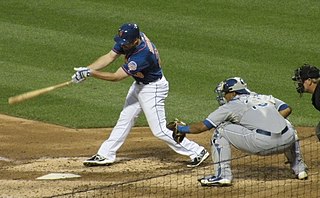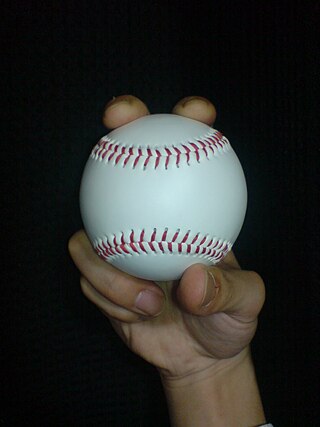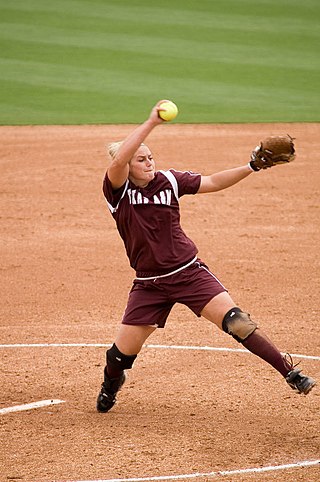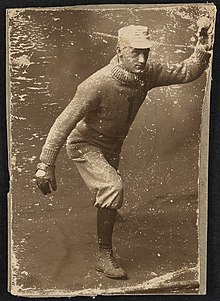
Softball is a game similar to baseball played with a larger ball on a smaller field, with only underhand pitches permitted. Softball is played competitively at club levels, the college level, and the professional level. The game was first created in 1887 in Chicago by George Hancock.

In baseball, the pitcher is the player who throws ("pitches") the baseball from the pitcher's mound toward the catcher to begin each play, with the goal of retiring a batter, who attempts to either make contact with the pitched ball or draw a walk. In the numbering system used to record defensive plays, the pitcher is assigned the number 1. The pitcher is often considered the most important player on the defensive side of the game, and as such is situated at the right end of the defensive spectrum. There are many different types of pitchers, such as the starting pitcher, relief pitcher, middle reliever, lefty specialist, setup man, and the closer.

Catcher is a position in baseball and softball. When a batter takes their turn to hit, the catcher crouches behind home plate, in front of the (home) umpire, and receives the ball from the pitcher. In addition to this primary duty, the catcher is also called upon to master many other skills in order to field the position well. The role of the catcher is similar to that of the wicket-keeper in cricket.

The fastball is the most common type of pitch thrown by pitchers in baseball and softball. "Power pitchers," such as former American major leaguers Nolan Ryan and Roger Clemens, rely on speed to prevent the ball from being hit and have thrown fastballs at speeds of 95–105 miles per hour (153–169 km/h) (officially) and up to 108.1 miles per hour (174.0 km/h) (unofficially). Pitchers who throw more slowly can put movement on the ball, or throw it on the outside of home plate where batters cannot easily reach it.

The forkball is a type of pitch in baseball. Related to the split-finger fastball, the forkball is held between the first two fingers and thrown hard, snapping the wrist.

In baseball and softball, the curveball is a type of pitch thrown with a characteristic grip and hand movement that imparts forward spin to the ball, causing it to dive as it approaches the plate. Varieties of curveball include the 12–6 curveball, power curveball, and the knuckle curve. Its close relatives are the slider and the slurve. The "curve" of the ball varies from pitcher to pitcher.

A changeup is a type of pitch in baseball and fastpitch softball.

A split-finger fastball or splitter is an off-speed pitch in baseball that looks to the batter like a fastball until it drops suddenly. Derived from the forkball, it is so named because the pitcher puts the index and middle finger on different sides of the ball.

In baseball, a starting pitcher or starter is the first pitcher in the game for each team. A pitcher is credited with a game started if they throw the first pitch to the opponent's first batter of a game. Starting pitchers are expected to pitch for a significant portion of the game, although their ability to do this depends on many factors, including effectiveness, stamina, health, and strategy.

A two-seam fastball is a pitch in baseball and softball. It is a variant of the straight fastball. The pitch has the speed of a fastball and can also include late-breaking action caused by varying the pressure of the index and middle fingers on the ball.

A four-seam fastball, also called a rising fastball, a four-seamer, or a cross-seam fastball, is a pitch in baseball. It is a member of the fastball family of pitches and is usually the hardest ball thrown by a pitcher. It is called what it is because with every rotation of the ball as it is thrown, four seams come into view. A few pitchers at the major league level can sometimes reach a pitch speed of over 100 mph. It is often compared with the two-seam fastball.

In baseball, a circle changeup or circle change is a pitch thrown with a grip that includes a circle formation, hence the name circle changeup. The circle is formed by making a circle with the index finger, holding the thumb at the bottom of the ball parallel to the middle finger and holding the ball far out in the hand. The ball is thrown turning the palm out.

Throughout the history of baseball, the rules have frequently changed as the game has continued to evolve. The rules of baseball can vary slightly from league to league, with there being dozens of leagues worldwide. A few common rules most professional leagues have in common is that four balls is a base on balls, three strikes is a strikeout, and three outs end a half-inning. One example of differing rules in professional leagues is the use of a pitch clock, which in Major League Baseball (MLB) is in place to speed up the pace of the game by forcing pitchers to pitch in a 15–20 second window, while in Nippon Professional Baseball (NPB) no such rule exists.
In baseball, an off-speed pitch is a pitch thrown at a slower speed than a fastball. Breaking balls and changeups are the two most common types of off-speed pitches. Very slow pitches which require the batter to provide most of the power on contact through bat speed are known as "junk" and include the knuckleball and the Eephus pitch, a sort of extreme changeup. The specific goals of off-speed pitches may vary, but in general they are used to disrupt the batter's timing, thereby lessening his chances of hitting the ball solidly or at all. Virtually all professional pitchers have at least one off-speed pitch in their repertoire. Despite the fact that most of these pitches break in some way, batters are sometimes able to anticipate them due to hints that the pitcher gives, such as changes in arm angle, arm speed, or placement of fingers.

A gyroball is a type of baseball pitch used primarily by players in Japan. It is thrown with a spiral-like spin, so that there is no Magnus force on the ball as it arrives at home plate. The gyroball is sometimes confused with the shuuto, another pitch used in Japan.
The shuuto (シュート) or shootball is a baseball pitch. It is commonly thrown by right-handed Japanese pitchers such as Hiroki Kuroda, Noboru Akiyama, Kenjiro Kawasaki, Daisuke Matsuzaka, Yu Darvish and Masumi Kuwata. The most renowned shuuto pitcher in history was Masaji Hiramatsu, whose famous pitch was dubbed the razorshuuto because it seemed to "cut the air" when thrown.

In baseball, sidearm is a motion for throwing a ball along a low, approximately horizontal plane rather than a high, mostly vertical plane (overhand).

Fastpitch softball, also known as fastpitch or fastball, is a form of softball played by both women and men. While the teams are most often segregated by sex, coed fast-pitch leagues also exist.
In baseball, the vulcan changeup pitch is a type of changeup; it closely resembles a forkball and split-finger fastball. It is a variation of the circle changeup, and when mastered can be extremely effective. Much like a forkball, the vulcan is gripped between two fingers on the hand, but rather than the middle and index finger as with the forkball or split-finger fastball, it sits in between the middle and ring fingers to make a v-shape when releasing to the catcher. It is thrown with fastball arm speed but by pronating the hand by turning the thumb down, to get good downward movement on it.
Im Gi-yeong is a South Korean professional baseball pitcher currently playing for the Kia Tigers of the KBO League.
















